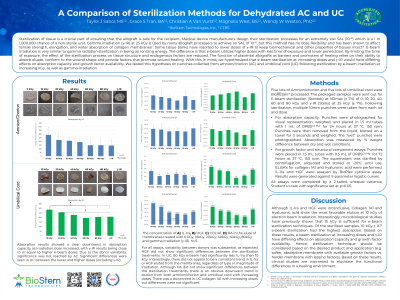Laboratory Research
(LR-022) A Comparison of Sterilization Methods for Dehydrated AC and UC

Sterilization of tissue is a crucial part of ensuring that the allograft is safe for the recipient. Sterility Assurance Level (SAL) is the probability that a single unit that has been subjected to sterilization nevertheless remains nonsterile. Medical device manufacturers design their sterilization processes for an SAL of 10−6. Gamma irradiation (γ-IR) is used by many allograft processers, but this method has no dose flexibility, and at the industry standard of 25 kGy, has been shown to affect tensile strength, elongation, and water absorption of collagen membranes. E-beam irradiation is very similar to γ-IR in being an ionizing energy. E-beam utilizes higher doses with less time of exposure and lower penetration, hence the effect of the sterilization process on tissue structure and endogenous factors should be reduced. With this in mind, we hypothesized that e-beam sterilization at increasing doses and γ-IR at 25 kGy would have differing effects on absorption capacity and growth factor availability.
Methods: Amnion/chorion (AC) and Umbilical cord (UC) were processed for dehydrated product. The packaged samples were sent out for E-beam sterilization at VDmax of 0, 10, 20, 40, 60 and 80 kGy and γ-IR. Following sterilization, 10mm punches were taken from each lot and dose. For absorption capacity, punches were photographed, weighed, and rehydrated in DPBS. Punches were removed from the liquid, blotted, weighed and re-photographed. Absorption was calculated as % weight difference between dry and wet conditions. For molecular assays, punches were incubated with DPBS for 72 hours. The supernatant was used for collagen 1A1, hyaluronic acid, IL-1ra and HGF assays. All assays were compared Student’s t-test with significance set at p< 0.05.
Results: In UC, 80 kGy e-beam had significantly less IL-1ra than 10 kGy. HA did not show significant differences between the sterilization treatments, but there is an obvious downward trend in elution with increasing doses. Absorption results showed a clear downtrend in absorption capacity as irradiation dose increased, with γ-IR results being close to or equal to higher e-beam doses.
Discussion: Based on these results, e-beam sterilization at increasing doses and γ-IR have differing effects on absorption capacity and growth factor availability. Hence, ideal sterilization technique should be based on the desired product and application (e.g. softer, absorptive membrane with available growth factors vs. stiffer membrane with less/no factors). Based on these results, clinical studies are warranted to elucidate the functional differences in a healing environment.
Trademarked Items:
References: Silindir Gunay M, Ozer Y. Sterilization methods and the comparison of E-Beam sterilization with gamma radiation sterilization. FABAD J Pharm Sci. 2009;34:43-53.
Komara et al. The Effect of Gamma-Ray Irradiation on the Physical, Mechanical, and Morphological Characteristics of PVA-Collagen-Chitosan as a Guided Tissue Regeneration (GTR) Membrane Material. European Journal of Dentistry. 2022. DOI: https://doi.org/ 10.1055/s-0042-1753451.
Singh R, Singh D, Singh A. Radiation sterilization of tissue allografts: A review. World J Radiol 2016; 8(4): 355-369. PMID: 27158422 DOI: 10.4329/wjr.v8.i4.355.

.png)